Memorials & Monuments
Published at DVHH.org 2004-2013 by Jody McKim Pharr |
|
|
|
|
|
|
Elek
(Bekes
County, Hungary - Danube Swabian Memorial
1939-1945, 450 names! |
|
|
|
|
|
|
|
Monument in Altker (Batschka)
Contributed
by Photographer Andrea Ballreich, also
translator
Auf
Diesem Plac war von 1827. Bis 1944. Jahre Friedhop
der Deutschen Evangelischen A.B. Kirchengemeinde in
Zmajevo.
I took these photos in September 2005. They show the
entrance of the former German cemetery in Altker
(today Zmajevo) in the Batschka. The text is: At
this place was the German Evangelical cemetery from
1827 until 1944.
I don't know
exactly when it was erected but it is the
most dignified German cemetery in the
Batschka that I've ever seen. Situated in
a nature reserved area and a man watches
everyone who visits the place.
When we were
there he asked us where we were from. And
when I said that some of my ancestors are in
that cemetery he got tears in the eyes and
showed us all around. | |  |
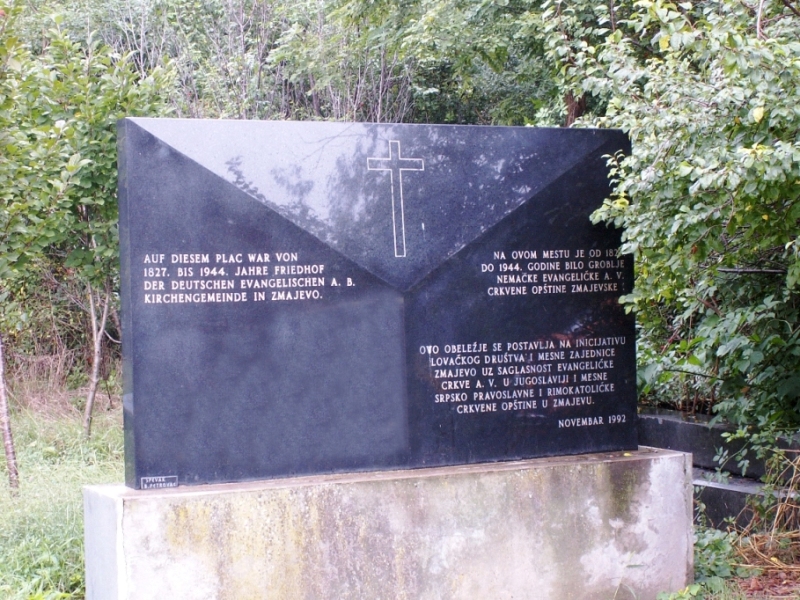
Contributed by
Andrea Ballreich

Batschsentiwan, Batschka - Prigrevica,
Vojvodina - The memorial garden
Photo by
Unknown
The memorial garden
site for the former Batschsentiwan, Batschka
is located on the old site of the cemetery
today's Prigrevica, Vojvodina. The former
citizens of Batschsentiwan negotiated with
the current town officials to salvage and
refurbish such monuments which were at large
being destroyed, moved or used for other
purposes. Through the untiring efforts of
the HOG Batschsentiwan and their present
president Ernst Jäger, it was possible to
interest such formers citizens who's grave
stone were reparable to volunteer to bear
the cost for doing so. With the erection of
this memorial garden, the former citizens
found a place they can visit in their old
home town once called "Heimat." The
dedication ceremony took place in May of
2005 and the pictures you see are from that
event.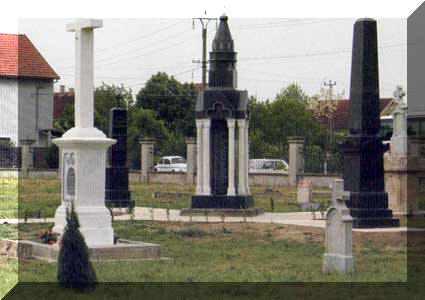 |
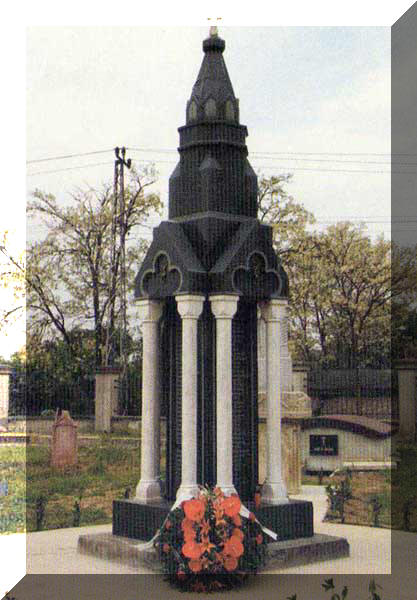 |
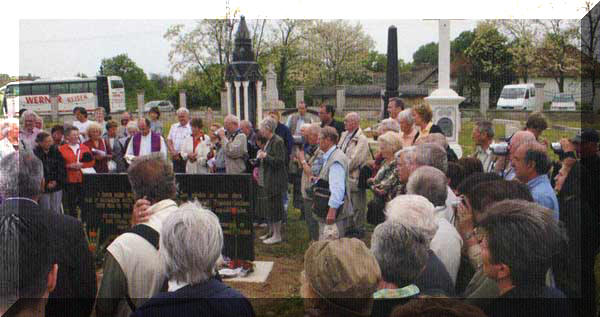
Contributed by Hans Kopp

Budaörs
(Hungarian Highlands) - Memorial to the Expulsion of the
Germans
From: Donautal-Magazin Jg. 30, Nr.
140 dated 1. August 2006, pp. 8-9.
Gedenk Kreuz
Kruschwel (more
information)

Contributed by
Nick Tullius

Cincinnati, Ohio - Danube Swabians
Memorial
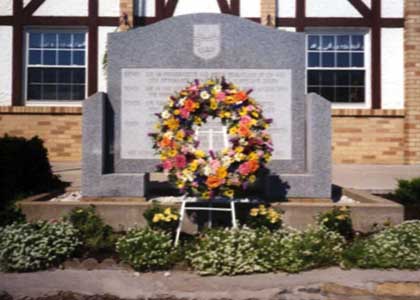
Contributed by
Hans Kopp

Cleveland,
OH - Danube Swabians Memorial
Contributed by Photographer Hans Kopp
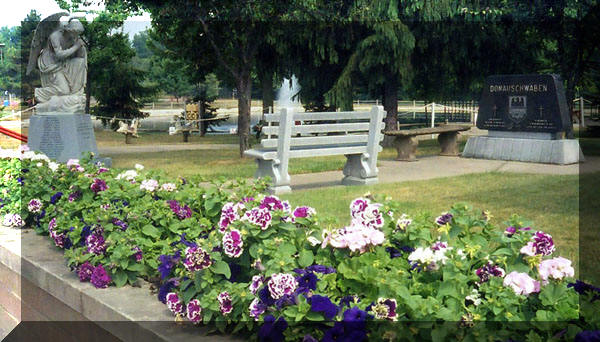

Elek
(Bekes
County, Hungary -
Bronze
Danube
Swabian sculptures.
Danube Swabian Memorial 1939-1945, 450
names listed!
(N. of Arad)
Contributed by
Jody
McKim,
Photos by her
cousins Axente & Renate
Formann

Danube
Swabian Memorial 1939-1945 in Elek
Danube Swabian Memorial stones,
450
names
listed!
(more
information
and
enlarged
images)
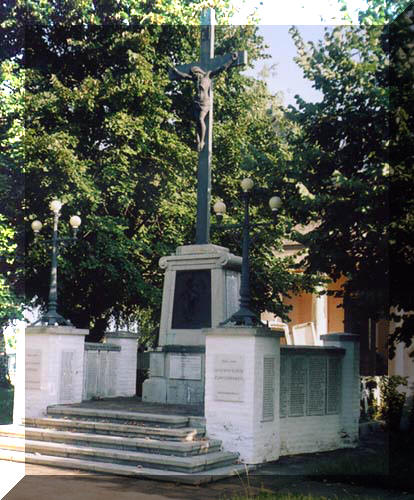
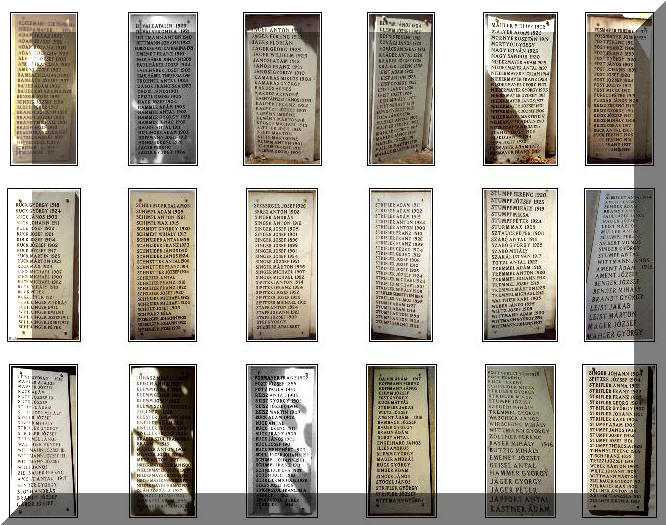
Contributed by
Jody
McKim,
images by cousins Axente & Renate
Formann

Gakowa, 2004
- The Danube
Swabians
Photos by Unknown
 |
Inscription:
A monument for our beloved, left
behind in the death camp of Gakowa.
We can forgive, but can not forget.
May this symbol of faith and peace
dwell in our hearts, only from the
innermost of our harts we will find
the strength, to bear our pain. May
these leaves and flowers delight
their souls. These leaves and
flowers originate from the cemetery
of Gakowa.
Here lay our
Danube Swabian compatriots, they
will remain in our hearts forever.
This cross has been raised in
respectful and dignifying memory of
them.
The Danube
Swabians are descendants of the
ethnic German settlers, who were
invited by the Habsburg emperors in
the 18th Century to colonize the
Panonian lowland.
[Gakowa concentration
camp March 1945 to January of 1948.]
|


Contributed by Hans Kopp

Krndija Monument
Photos
by Unknown
For the
3,000 Donauschwaben who found
their resting place in the mass graves in the
cemetery in Krndija (former Slavonia).
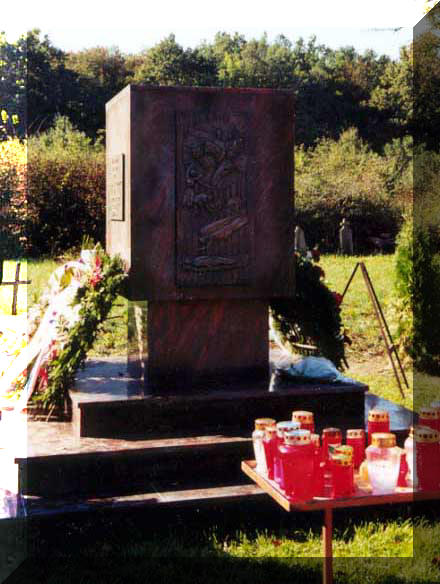
Contributed by Hans Kopp

Kruschiwl
Monument - Gedenk
Kreuz Kruschwel
Photos by
Unknown
(at the
cemetery)
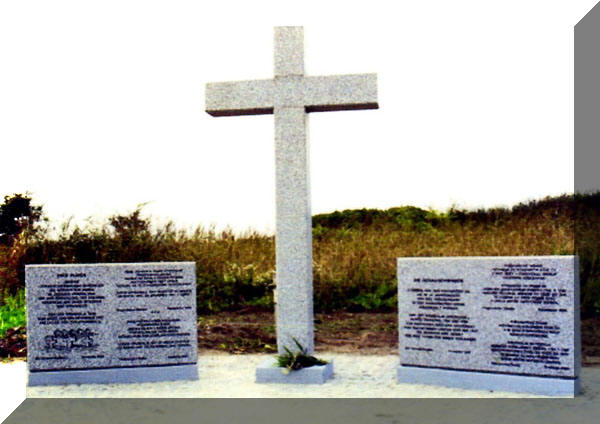
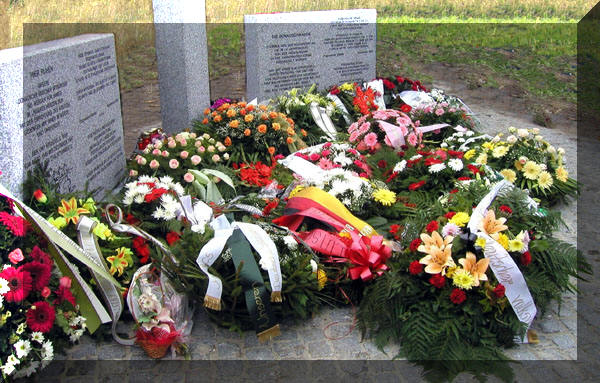
Contributed by
Hans Kopp

Nikolaus Lenau Memorial
House - Lenauheim/Csatâd,
Banat, Romania
Contributed by Photographer Jody
McKim Pharr, 2004
(For more
information and photos see:
www.dvhh.us/lenauheim/nikolaus-lenau/index.htm)

Photographed and Contributed by
Jody McKim

Banater
Schwaben Memorial,
Mannheim, Germany
Transcribed and Contributed by
George Brettrager
The Banater Schwaben
Memorial located in the main
Cemetery of Mannheim, Germany,
was established
22 Jul 2001. Dedicated to the Banater
Schwaben and Berglanddeutsche who were
victims of the World
Wars, Yugoslavian
extermination camps,
abduction to Russia and
Baragan deportation. The Mass was celebrated by
Fr. Kaufmann from the
homeland and Fr. Reinelt.
Richard S. Jäger, Chairman
of H.O.G.
Neupanat, was
instrumental in erecting
the monument inscribed with
list of villages where these
people lived.
Memorial to the Banater Swabians
Unveiled in
Mannheim Main Cemetery
by Richard S. Jäger,
(German) Translated by George
Brettrager
see:
North side
of Monument inscriptions
&
South side of
Monument inscriptions
Monument Inscription
Translation...
Transcribed and Contributed by
George Brettrager
|
Banater
Swabians
and
Bergland
Germans
THE
VICTIMS
of
the
World
Wars
1914-1918
1939-1945
Of
the
extermination
camps
of
the
Tito
regime
1944-1948
Of
the
abduction
to
Russia
1945-1949
Of
the
Baragan
deportation
1951-1956
THE
DEAD
of
the
homeland
of
the
flight
and
expulsion
of
the
new
homeland
(DS
Coat
of
Arms)
 FORGET
THEM
NOT
|
|
|

§
Location:
The Hauptfriedhof (main cemetery) is in the NE side of town,
just north of the Neckar River, on
Hauptstrasse. Go east on Hauptstrasse
from B38 north of the Neckar; or north on
B38A from the Mannheim airfield to
Hauptstrasse, then west. Within the
cemetery it is just north of
a colonnade which houses
really old stones in the
cemetery. Most Mannheimers
would know the way to the Hauptfriedhof.
§
|
Inscriptions,
translations and
photos were
kindly
contributed by
George Brettrager,
of Loves Park,
Illinois,
whose villages of interest are
Glogowatz and
Neupanat in
Banat. |
 |
See:
banater-schwaben.org/index.php?id=103
|
|
|
|
|
North
side of monument
Transcribed by
George Brettrager

|
& inscriptions
|
Neudorf |
Places in the
Banat/Yugoslavia |
|
Neuhof |
Alt-letz |
|
Neukaransebesch |
Brestowatz |
|
Neupanat |
Charleville |
|
Neu- und
Großsanktpeter |
Deutschelemer |
|
Neusiedel |
Deutschzerne |
|
Nitzkydorf |
Ernsthausen |
|
Ofsenitz |
Etschka |
|
Obad |
Franzfeld |
|
Orawitz |
Georgshausen |
|
Orschowa |
Glogon |
|
Orzydorf |
Großbetschkerek |
|
Ostern |
Großkikinda |
|
Pankota |
Heideschütz |
|
Paratz |
Heufeld |
|
Paulisch |
Homolitz |
|
Perjamosch |
Jabuka/Apfeldorf |
|
Perkos |
Karlsdorf |
|
Pesak |
Kathreinfeld |
|
Rekasch |
Kubin |
|
Reschitz |
Kudritz |
|
Rußberg |
Klek |
|
Sakelhausen |
Lazarfeld |
|
Saderlach |
Mastort |
|
Sanktandreas |
Modosch |
|
Sanktanna |
Mokrin |
|
Sanktmartin |
Molidorf |
|
Sarafol |
Mramorak |
|
Sentlein |
Nakodorf |
|
Schag |
Pantschowa |
|
Schimand |
Pardan |
|
Schöndorf |
Ploschitz |
|
Segenthau |
Rudolfsgnad |
|
Sekul |
Sartscha |
|
Semlak |
Setschan |
|
Sigmundhausen |
Setschanfeld |
|
Steierdorf-Anina |
Sigmundsfeld |
|
Temeschburg |
Soltur |
|
Tolwad |
Sanktgeorgen |
|
Traunau |
Sankthubert |
|
Triebswetter |
Startschowa |
|
Tschakowa |
Stefansfeld |
|
Tschanad |
Tschestereg |
|
Tschawosch |
Weißkirchen |
|
Tschene |
Werschetz |
|
Ulmbach |
Zichydorf |
|
Waldau |
Ruskodorf |
|
Warjasch |
|
|
Weidenthal |
Places in the
Banat/Hungary |
|
Wetschehausen |
Alt- und
Neusanktiwan |
|
Wiesenhaid |
Elek |
|
Wiseschdia |
Kübekhausen |
|
Wojteg |
|
|
Wolfsberg |
|
|
Zipar |
|
|
|
|
|
South
side of the monument
Transcribed by
George Brettrager
|
430,000
Germans
lived in
the
Banat in
1941.
Places
founded,
settled
and
inhabited
by
Germans
in the
Banat/Romania. |
|
 |
&
inscriptions
|
Albrechtsflor |
Grabatz |
|
Alexanderhausen |
Großdorf |
|
Altringen |
Großjetscha |
|
Altsadowa |
Großkomlosch |
|
Arad |
Großscham |
|
Aurelheim |
Guttenbrunn |
|
Bakowa |
Hatzfeld |
|
Baratzhausen |
Hellburg |
|
Baumgarten |
Hodon |
|
Bethausen |
Jahrmarkt |
|
Billed |
Johannisfeld |
|
Birda |
Josefsdorf |
|
Blumenthal |
Kalatscha |
|
Bogarosch |
Karansebesch |
|
Bresondorf |
Keglewichhausen |
|
Bruckenau |
Kleinbetschkerek |
|
Butin |
Kleinjetscha |
|
Buchberg |
Kleinomor |
|
Busiasch |
Kleinsanktnikolaus |
|
Charlottenburg |
Kleinsanktpeter |
|
Darowa |
Kleinschemlak |
|
Denta |
Kleinsiedel/Ketfel |
|
Detta |
Klopodia |
|
Deutschbentschek |
Knees |
|
Deutschbogschan |
Königsgnad-Tirol |
|
Deutschpereg |
Königshof |
|
Deutschsanktmichael |
Kowatschi |
|
Deutsch-und-Großsanktnikolaus |
Kreuzstätten |
|
Deutschsanktpeter |
Lenauheim |
|
Deutschstamora |
Liebling |
|
Dognatschka |
Lindenfeld |
|
Dolatz |
Lippa |
|
Ebendorf |
Lovrin |
|
Eichenthal |
Lugosch |
|
Engelsbrunn |
Lunga |
|
Ferdinandsberg |
Marienfeld |
|
Franzdorf |
Matscha |
|
Fratelia |
Mercydorf |
|
Freidorf |
Morawitz |
|
Gertianosch |
Moritzfeld |
|
Gier |
Nadrag |
|
Giroda |
Nero |
|
Giseladorf/Panjowa |
Neuarad |
|
Giulwess/Iwanda/Rudna |
Neubeschenowa |
|
Glogowatz |
Neuburg a.d.
Bega |
|
Gottlob |
|
|

Memorial to the Banater Swabians
Unveiled in
Mannheim Main Cemetery
by Richard S. Jäger,
First Chairman of
AKdFF
&
Chairman of
H.O.G.
Neupanat
Translated
and Contributed by George
Brettrager
On Sunday the 22nd
of July 2001, the Kreisverband
Mannheim of the Landsmannschaft
der Banater Schwaben e.V.
issued an invitation to a
memorial event on the occasion
of the 50th anniversary of the deportation
of 10,000 Banater Schwaben to
the Baragan Plain.
Three thousand Germans from the Banat live
in Mannheim and Baden-Württemberg is the sponsor state of the
Banater Schwaben. More than 500 participants—among them a
Swabian lady still living in the Banat—followed the appeal of
the Kreisverband under the
leadership of the district
chairman Richard S. Jäger to the
memorial event.
After the solemn
entry of the banner delegations,
couples dressed in traditional
costume, the priests and
honorary guests, the memorial
event took place. The choir of
the Banater Schwaben sang the
song “O Baragan, o Baragan,
jetzt sind wir in der Wüste dran”
at the opening. After the
greeting to the honorary guests,
the district chairman of the
Banater Schwaben, Richard S.
Jäger, outlined the life of
suffering of his compatriots
after the Second World War.
“Nobody has had to pay as
cruelly for the most brutal war
of all times as the expatriate
Germans. Revenge and
retaliation were practiced on
you; even six years after the
end of the war—when peace
prevailed in the rest of
Europe—ten thousand innocent
people, children and old people,
were deported to the wide Plain
of Baragan in the vicinity of
the Black Sea just because they
were Germans. Not until 1956
were these innocent people
allowed to return to the Banat
homeland. Already in January
1945, eighty thousand Germans
from Romania were abducted to
the Soviet Union for 5 years of
forced labor; 15,000 were
starved to death there.” State
Legislature Representative Klaus
Dieter Reichardt—also on behalf
of the representative of the
state government for expelled
people and emigrants, Secretary
of State Heribert Rech MdL—and
CDU
party Chairman Dr. Sven-Joachim
Otto—also on behalf of the mayor
of the City of Mannheim—invited
by Kreisverband Mannheim of the
Landsmannschaft der Banater
Schwaben e.V., unveiled a
memorial stone in the main
cemetery. This draws attention
to the fate of the Germans who
fled and resettled from Romania,
the former Yugoslavia and, to a
smaller extent, from Hungary,
who—as District Chairman Richard
S. Jäger emphasized—“have found
a new, very good home in
Mannheim.” “Expulsion and
trampling of human rights under
foot must be prevented in Europe
forever,” Party Chairman Dr.
Otto described a lesson from
history like that; which the
party chairman of the SPD,
Dr. Frank Mentrup, also endorsed
in his greeting. He also
reminded that one is not allowed
to treat people inhumanely on
the basis of ethnic origin, of
background.
Klaus Dieter
Reichardt cautioned against
conducting the necessary battle
against the extreme right
excesses in German politics and
at the same time forgetting the
battle against extreme left
excesses. “As it was right to
fight the Republicans
politically, it is wrong to make
the PDS
acceptable politically.”
The district
chairman of the CDU, Professor
Dr. Egon Jüttner, reaffirmed in
his greeting: “The CDU remains
especially closely connected to
the exiles and emigrants who
have found a new home in Germany
and have given up revenge.” He
demanded the reversal of the cut
in the means for cultural and
historic work of the exiles and
that the City of Mannheim now,
through the city archives, works
up the history of the displaced
persons who came to the city
after 1945 was universally
approved on the initiative of
the CDU district council
faction. Other honorary guests
were the CDU City Councilwoman
Regina Trösch and Wolfgang
Schwöbel, manager of the
Mannheim cemeteries. For the
federal association of the
Landsmannschaft der Banater
Schwaben, the deputy federal
chairman Bernhard Krastl spoke;
he thanked the district chairman
and the entire Kreisverband for
the exemplary work in the
service of our ethnic group.
Others present were: Josef
Jerger, state chairman of the
Donauschwaben
in Rheinland-Pfalz, and Johann
Leitenbor, chairman of the
Kreisverband Frankenthal and
many HOG
chairmen.
After the memorial
speeches, a solemn Mass took
place, celebrated by homeland
priest Kaufmann and Fr. Reinelt
from the St. Laurentius Church
in Mannheim-Käfertal. Fr.
Reinert, who experienced the
fate of the exiles from the
Sudetenland
himself, said in his sermon,
“like 50 years ago, we celebrate
the Mass today in the open air,
when tens of thousands of people
were abandoned in a desert
steppe, had to dig themselves a
hole in the earth and only one
protected them, Our Lord Jesus
Christ. Faith and trust in God
were for the Banater
Schwaben—like for most of the
exiles—the last glimmer of
hope.”
They then set off in
a procession to the unveiled
memorial to the Banater
Schwaben. Dr. Otto—on the part
of the City of Mannheim—and
State Legislature Representative
Reichardt—on the part of the
sponsor state
Baden-Württemberg—carried out
the unveiling. Fr. Reinelt gave
the blessing. Richard S. Jäger,
district chairman of the Banater
Schwaben, presented the memorial
and declared: “this stone is a
memorial to the language, a
stone book of contemporary
history. It is a memorial
against war and against the
destruction which it brought
about; a memorial against ethnic
cleansing and disregard for
human rights. For our victims
and deceased, this is a worthy
memorial and for we living a
piece of lost homeland.” On the
sides of the memorial, 202
former German villages in the
Banat are immortalized by name.
Three former
deportees laid down a wreath
with 50 red roses for their
fellow sufferers who died in the
deportation during the song “Ich
hatte einen Kameraden.”
The ceremony was surrounded
musically by the “Evangelischen
Stadtposaunenchor Mannheim
e.V.,”
under the direction of Josef
Krug and the Banater Choir from
Frankenthal under the direction
of Mrs. Muhl. A really special
thanks to Wolfgang Schwöbel,
manager of the Mannheim
cemeteries, who cosponsored this
impressive ceremony.
The collection—which
was intended for the erection
and care of the
memorial—produced 1405.7 DM.
Please direct other donations
for the memorial to
Landsmannschaft der Banater
Schwaben – KV Mannheim, Konto
34045941 BLZ 67050505 with the
Sparkasse Rhein-Neckar-Nord.
Sincere thanks to all
contributors.
Since the charitable
status is recognized for the
Kreisverband Mannheim, sums of
money are tax-deductible as
special expenses. For donations
up to 100 Euro, the submission
of the transfer order satisfies
the tax office. Certificates of
donation are gladly issued on
request. A videocassette of the
entire ceremony can be ordered
with Kreisverband Mannheim.
Tel.: 0621-3365886.
The Board
Compatriot Group of the
Banater Swabians,
registered organization
O
Baragan, o Baragan, we
are in the desert now.
Member of the
Legislature
Christian Democratic
Union
German Social Democrat
Perty
Xenophobic,
nationalistic extreme
rightwing party in
Germany
Democratic-Socialist
Party
Heimatortsgemeinschaft –
Hometown Association
An area in western Czech
Republic
Evangelical City
Trombone Band of
Mannheim
[Published at DVHH.org,
Oct. 2004]

Mansfield, Ohio
- Danube Swabians Memorial
Photos by
Unknown

Contributed by
Hans Kopp

New Jersey
- Danube Swabians Memorial
Photos by
Unknown
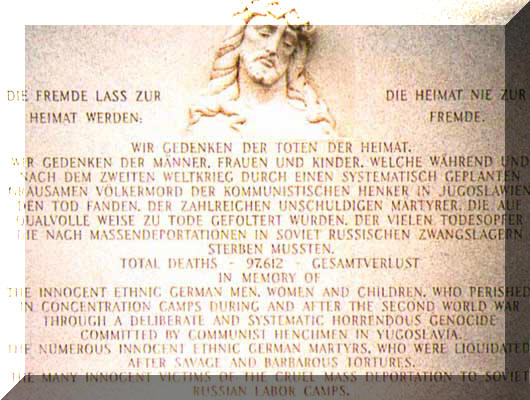
Contributed by
Hans Kopp

Palatinate, Germany - Monument in
the Cemetery at Batschsentiwaner Schifferstadt
Photos by
Unknown
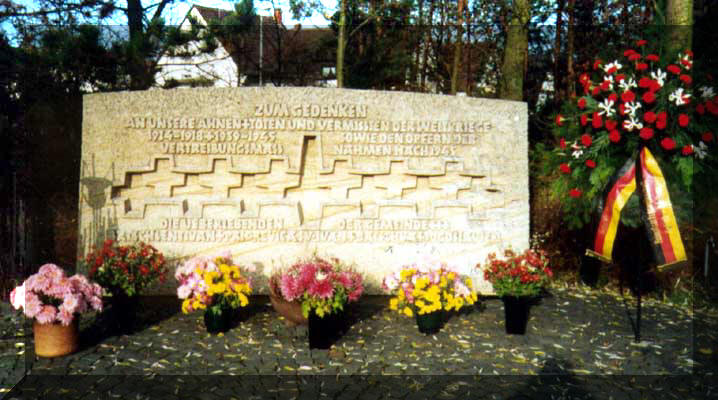
Contributed by
Hans Kopp

Regensburg
Photos by
Unknown
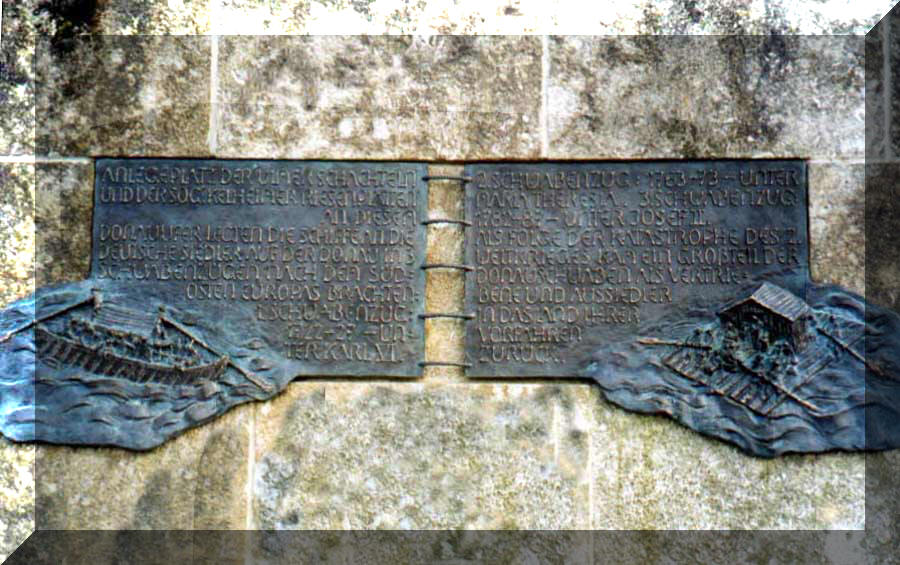
Contributed by
Hans Kopp

Ridgewood, NY
- Linden Hill Cemetery
Contributed by Photographer Thomas C. Stalzer, 06 Sep 2011
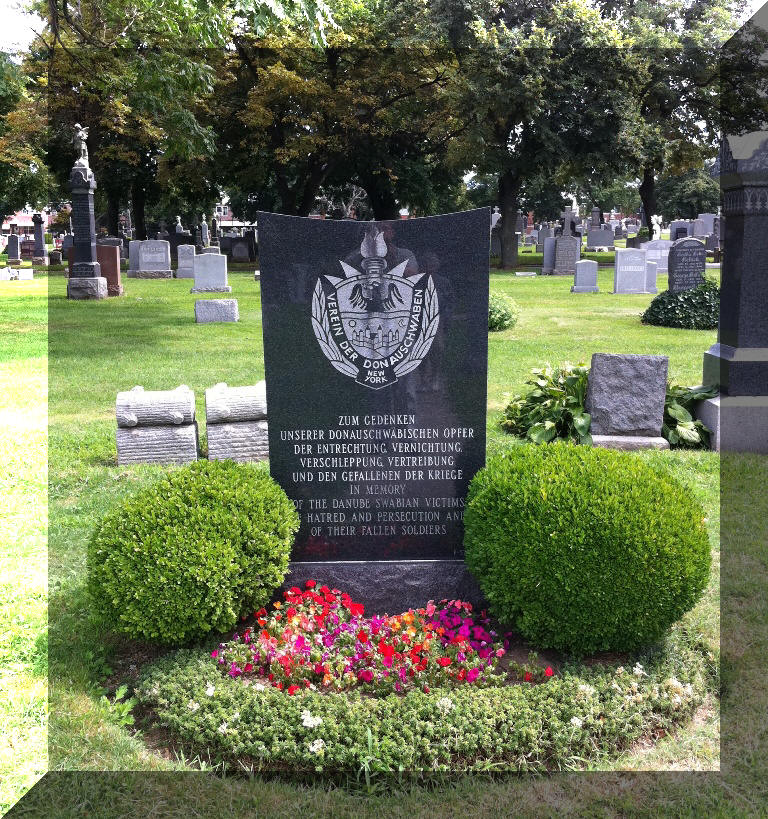
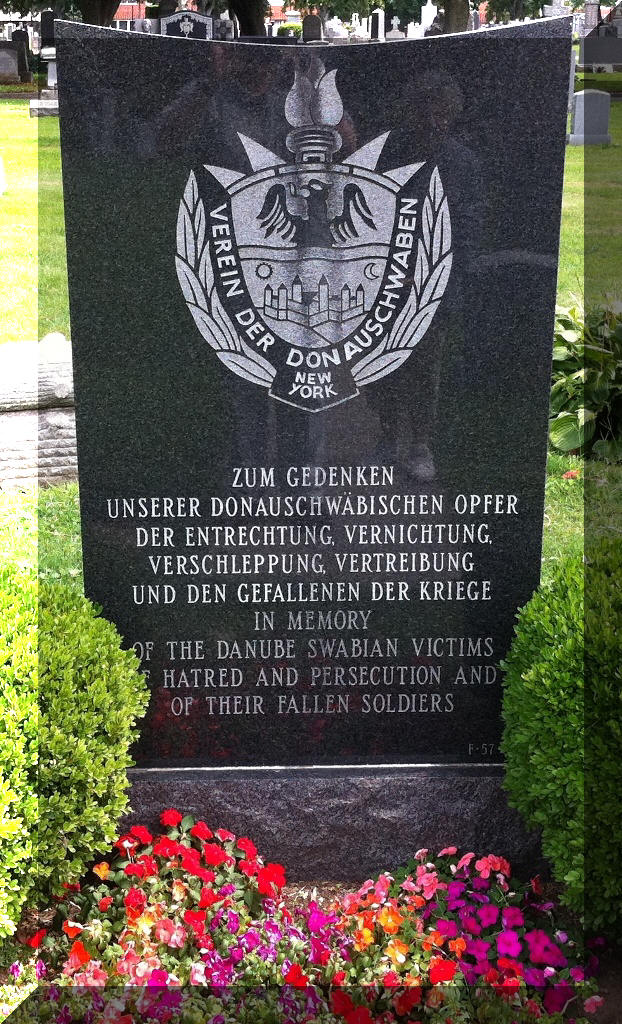
Contributed by Thomas C. Stalzer, 06 Sep 2011

Rudolfsgnad
Photos by Unknown
On November 4th,
2001, in a dignified ceremony, the 12,000 dead of Rudolfsgnad
were remembered;
3,000 are buried at the cemetery of Rudolfsgnad
(Knicanin) while 9,000 lie in mass graves on the Teletschka.
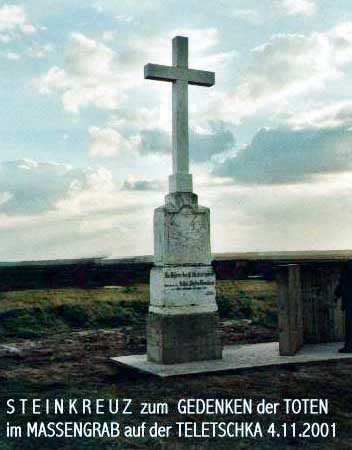

Contributed by
Hans Kopp

Sindelfingen,
Germany -
The Corpus Christy are located at
the "Memorial Garden" in Haus der
Donauschwaben
Photos by Unknown
The Corpus Christy
erected on the wall is original from Batsch-Brestowatz and was on a cross
in front of the church prior to
1945. It was found in a dump by
Franz Wesinger who smuggled it to
Germany were it was re-gold plated
and erected as lasting monument to
our loved ones our faith and
suffering.

The walls
are in memory of the victims of the
post "World War II" victims in
Communist Yugoslavia.
Imprinted in
the walls are the names of the towns
and the number of victims the towns
have suffered.



Contributed by Hans Kopp

St. Louis, MO - Danube
Swabian Memorial
Contributed by Photographer Connie Nisinger

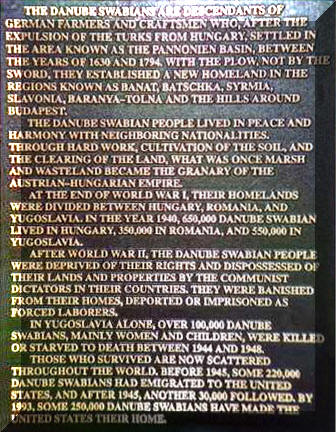
Contributed by Connie Nisinger

Teletschka Grave Sites
Photos by Unknown
(Dr. Georg Wildmann) The monument at
Teletschka is at the mass grave sites near Rudolfsgnad,
the
former Banat were 9,000 Donauschwaben victims found their last
resting place.
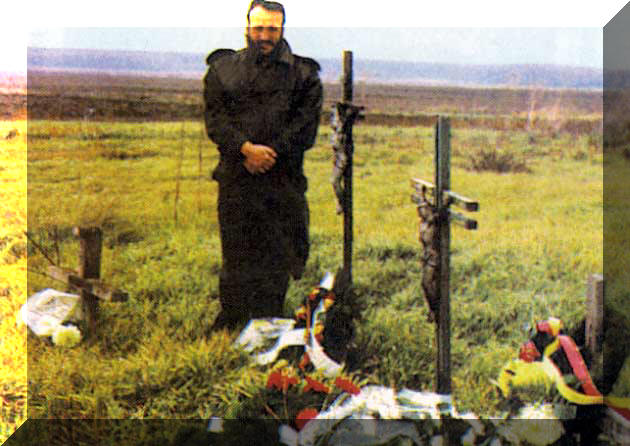
Contributed by
Hans Kopp

Tscherwenka - Memorial in the cemetery
Contributed by Photographer
Noelle Giesse
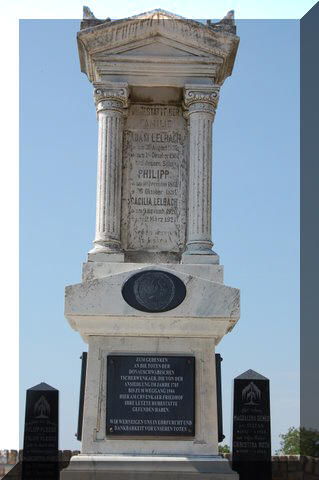


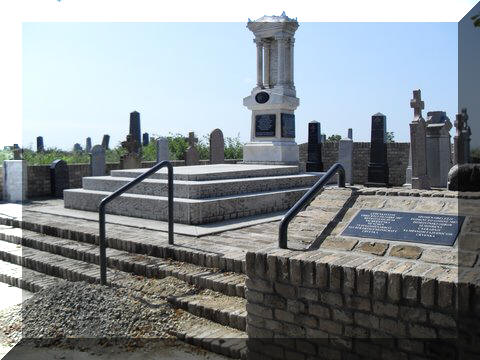
Contributed by Noelle Giesse

Ulm,
Germany - Emigrant Monument
Contributed by photographer
Jody McKim Pharr, 2004
Located
along the banks of the Danube River. The
Homeland Association of the Banater
Swabia lays a wreath.
Wall of Honor For The
Donauschwaben
Adjacent to the above Emigrant Monument.
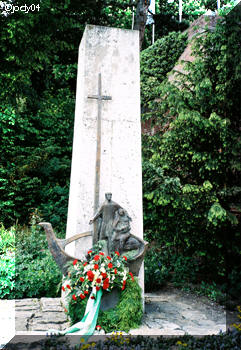

Below: Click on each
village name to enlarge the insert.
|

den Toten
|

Banater Swaben
|
|
|
|
|
|